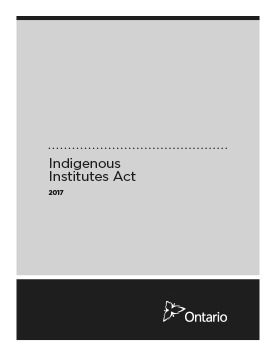INDIGENOUS EDUCATION
INDIGENOUS
Post-Secondary Education (PSE) PILLAR
In 2017, the Government of Ontario passed The Indigenous Institutes Act, recognizing Ontario’s Indigenous owned and operated Institutes as a foundational pillar of Ontario’s Post-Secondary Education system to sitting alongside the province’s colleges and universities.
For over 30 years, Indigenous Institutes across Ontario have delivered skills, training and education to Indigenous and non-Indigenous students alike through an Indigenous lens. This means delivering programs in Indigenous languages and focused on Indigenous traditions and practices as a means of both preserving and strengthening Indigenous culture, hosting programs and courses in remote communities and on reserves so that learners can access education where they live, supporting lifelong learning so that learners are able to grow with their communities, and delivering programs that will directly impact and serve the Indigenous communities across the province (particularly in the trades).

Indigenous Youth are the fastest growing population group in Ontario. Across the province, over half of the First Nations population is between 15 and 29. However, fewer Indigenous students attend post-secondary education than the rest of the population, and fewer graduate from these programs.
Why is this so?
One reason is that the structure and delivery of many mainstream post-secondary institutions come with barriers for Indigenous students. These schools are often far from where students live, which means students must leave home and pay more for access. They do not necessarily cover the skills Indigenous students need for success, and while many have begun to offer programs that address Indigenous perspectives, their programs do not offer teachings based around Indigenous culture and traditions.
The education offered by Ontario’s Indigenous Institutes directly address these barriers.
The IIC knows that learners benefit from education that includes their needs and Indigenous Education supports Indigenous students by delivering education in a way that will help them advance their knowledge, build stronger communities and maintain their ties to Indigenous education.
Invest in
Indigenous Education
There is a significant gap between Indigenous and non-Indigenous students in post-secondary education. We must invest in Indigenous Education to close that gap, so that all students have the same opportunities to develop the skills and knowledge to benefit themselves, their families, and their communities.
But investing in Indigenous Education is not only an opportunity to support Indigenous students and communities, it is also an opportunity to drive economic benefits for the province as a whole. As described in the Roadmap to Recognition for Aboriginal Institutes paper:
“Closing the education gap between Aboriginal and non-Aboriginal students is an opportunity, particularly for Ontario, where Indigenous communities are playing an increasing role in the resource economy. By one estimate, closing the gap could result in cumulative benefits of up to $400.5 billion across Canada from 2006-2026, and save an additional $115 billion in government expenditures. Aboriginal Institutes play a key role in closing the gap, by linking communities and learners with the education and skills that are in demand.”


